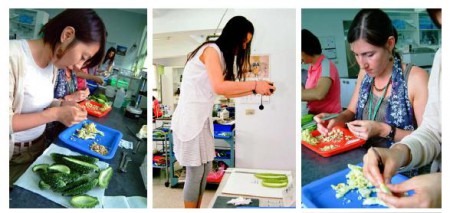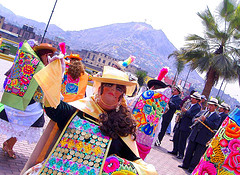- July issue of CSA News, official magazine for members of the American Society of Agronomy, Crop Science Society of America and Soil Science Society of America, has article on “Crop Adaptation to Climate Change” based on official CSSA position statement, “Crop Adaptation to Climate Change.”
- Factsheet on bacterial diversity and why it’s good for soils.
- FAO guidelines for the In Vivo Conservation of Animal Genetic Resources discussed in Europe.
- Please eat the daisies. Or other flowers.
- Farming chips.
- Never thought I’d get bored of reading about ancient beer.
Nibbles: Median strips, Vitamin A, Mapping in Kenya, Chaffey, Small farms, Rennell Island coconuts, Sweet potato breeding, Acacia nomenclature, Crop models, Pulque, Fruits
- Planting roadsides with natives, including crop wild relatives. And here comes the database.
- Orange Maize: The Movies.
- VirtualKenya really here. Mother-in-law beside herself.
- Plant Cuttings is out. And all of a sudden I’m in a much better place.
- Small is beautiful, farm edition. And as chance would have it, coffee farm edition. And urban edition.
- Dispute at iconic coconut plantation resolved. Apparently there are some really unique varieties there.
- I say boniato. For the first and last time.
- Acacia on the brink. Easy, tiger. The name, not the genus.
- We’re going to need a better model.
- Pulque comes back. Never knew it had gone away.
- Domesticating fruit trees in Kenya. Something for VirtualKenya?
Making the most of bitter gourd diversity at AVRDC
Another interesting agrobiodiversity piece in AVRDC’s newletter today:
The AVRDC Nutrition group is locked in a struggle with a cucurbit – and so far, warty Momordica charantia appears to be winning! As part of the project “A better bitter gourd: exploiting bitter gourd to increase incomes, manage type 2 diabetes, and promote health in developing countries,” researchers have begun preparing samples of the vegetable for later laboratory analysis.

Interested? “Like” the project’s Facebook page then!
Nibbles: G20, Chickens, Yucca flowers
- Advice to the G20: “hunger is neither the result of demographic problems nor just the result of a mismatch between supply and demand”.
- Let there be chickens! Picture goodness from National Geographic.
- How to cook yucca flowers. And eat them, obviously.
Andean products on display
 The Fifth Potato Festival is underway in the Surco district of Lima, Peru. It sounds like fun, but all the information about it online at the moment is in Spanish only. If you don’t read the language, and can’t be bothered fighting with the results of Google Translate, you can read a short piece on last year’s event in English. It’s actually about much more than just the potato. There are stands on a whole range of new Andean products:
The Fifth Potato Festival is underway in the Surco district of Lima, Peru. It sounds like fun, but all the information about it online at the moment is in Spanish only. If you don’t read the language, and can’t be bothered fighting with the results of Google Translate, you can read a short piece on last year’s event in English. It’s actually about much more than just the potato. There are stands on a whole range of new Andean products:
…black quinoa, royal quinoa, red quinoa, quinoa sajama, maca, instant amaranth, instant cañihua, wheat, red corn, corn chullpi, bean mashco, barley mashco, black potato, white potato flour, etc.